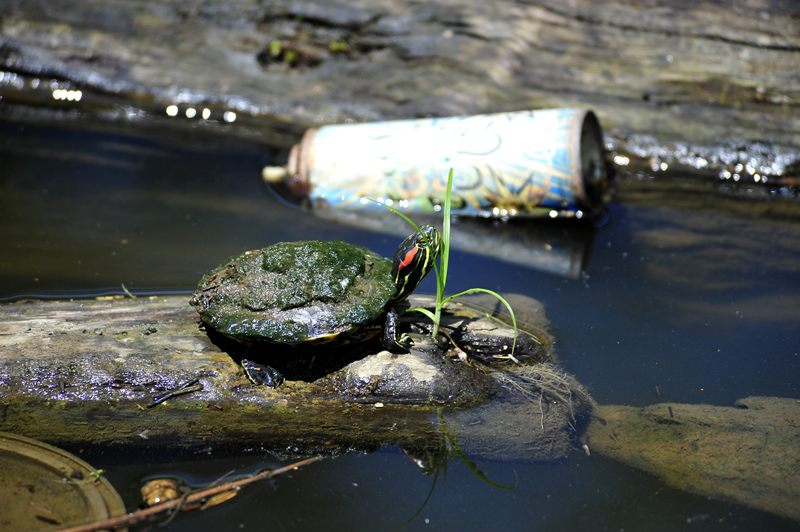29
Fixing Anacostia Pollution Won’t Be Quick

A young Eastern painted turtle, covered in algae, basks on some driftwood while a discarded spray paint can floats nearby in the Anacostia River. (News21 photo by Jason Lenhart)
WASHINGTON – Renovations to the Blue Plains Wastewater Treatment Plant — needed to help shore up an antiquated sewer system in the nation’s capital — are a year ahead of schedule, with completion expected in 2014, D.C. Mayor Adrian Fenty says.
But even with the updates, controlling raw sewage runoff into the Anacostia River during heavy rains may remain an issue until at least 2018, say the District’s water and sewer authority and environmental advocates.
The long-standing problem: There isn’t enough space in combined sewage and stormwater pipes to effectively transport untreated runoff to the Blue Plains plant.
“When those pipes reach capacity, overflow valves flip over,” says Brent Bolin, director of advocacy for the Anacostia Watershed Society. “Essentially, raw sewage is discharged into the Anacostia River.”
Urban development in the Anacostia watershed has exacerbated the problem, he says. “As D.C. gets more and more built out, there’s more and more impervious surface and more and more runoff.”
The long-term solution, Bolin says, is to dig an eight-mile long tunnel that will capture and store excess storm water until it can be processed at Blue Plains. The Metrorail-sized tube will run from near RFK Memorial Stadium to Blue Plains.
“We applaud that they’re addressing the problem,” Bolin says. “But it’s a big engineering fix. It’s going to be a process to get through it.”
Currently, when overflows occur, thousands of gallons of polluted stormwater flood the river, exacerbating poor conditions of a river already deemed unsafe for swimming or fishing. (See map of overflow points.)
The overflows occur as many as 80 times a year, D.C. Water officials say. Their frequency is estimated using a model based on the amount of rainfall in a given year.
The renovation and tunnel fixes could reduce the number of combined sewer overflows to two a year, D.C. Water officials say. Reaching zero would make the cost of the project “magnitudes higher” than the current $2.5 billion price tag, according to analyses by D.C. Water and the Environmental Protection Agency.
The move to stifle sewage overflow events has been going on for more than 50 years, but the history of the sewer system goes back more than a century. In the late 1800s, Washington’s combined sewer system was considered to represent the best engineering standards available.
Fenty acknowledged after a meeting this month with the governors of Maryland and Virginia and environmental leaders that oversight could be better. “In the history of our city, our great nation’s capital, we haven’t always protected the rivers,” he said.
D.C. Water’s wide-ranging, $2.5 billion program includes constructing runoff tunnels to alleviate pressure on the Anacostia and Potomac rivers and Rock Creek.
“Right now, the grid is overwhelmed,” Bolin says. “There are two things you can do: You can give an outlet to the grid, or you can prevent the inputs.”
Source controls such as increased street sweeping, adding catch basins, and promoting low-impact development and green roofs could help alleviate the stress on the combined sewer, Bolin says.
–by Justin Karp
About Us
Our Stories
- Md. Officials May Temporarily Lift Ban on Female Crab Harvest in Bay
- Scientists, Environmentalists Question Readiness of Chesapeake Bay Disaster Plans
- Inner Harbor Water: Unsafe Bacteria Levels, Test Shows
- Swimmers’ Impressions of Bay Not Always in Sync With Its Health, Scientists Say
- Chesapeake Bay Swim Attracts Hundreds in Balmy Conditions, But Course Includes ‘Dead Zone’















